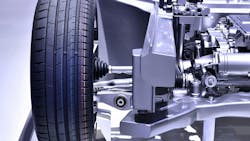Inverter-Motor Integration Can Deliver Benefits—But It Takes Planning (Download)
Facing cost constraints and a need to save weight and minimize costs, designers are increasingly considering integrating inverter and drive units in electric vehicles (EVs).
Integration of inverters directly into the electric motor and transmission reduces the size, weight, and wiring complexity of the powertrain. Such designs can also optimize thermal management for the entire system and potentially simplify the EV manufacturing process by streamlining vehicle assembly.
Integrating the traction inverter with the drive unit (motor) is sometimes known as "eAxle" or "powertrain integration." However, offsetting its advantages in efficiency and packaging simplification is a set of complex engineering challenges. In other words, it takes thought and effort to secure those potential advantages.
